Afghan clothing


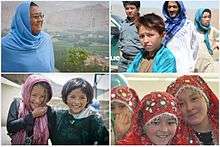
Afghan clothing styles reflect that Afghanistan is home to various ethnicities including the Tajiks, Pashtun, Hazara, Uzbek and smaller populations of Aimaq, Turkmen, Baloch, Pashayi, Nuristani, Arab, Brahui, Pamiri, and Gurjar. They have their own particular traditions.
Styles
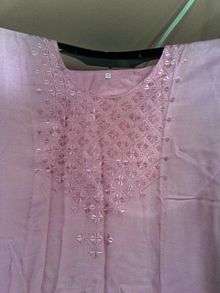
Men's clothing includes the khet partug, perahan tunban, the turban and local styles of coats.
Generally, traditional women's dresses in Afghanistan are made from light linens and are loose fitting for ease of movement. They come in many colors and have stitching for details. One unique style of casual women's dress is the Kandahari doozi embroidery stitching of the city of Kandahar. This is stitching very intricately in the linens in different shapes and patterns using very thin threads. The more intricate the design, the more pricey the garment.

More elaborate and fancier dresses are detailed with gold threading (Zardozi), gold beads, and come in many different colors on silk fabrics. These dresses are usually worn to special occasions and weddings. Some women still wear burqas, even after the Taliban's fall in 2011.
Pashtun
As a chiefly rural and tribal population, the Pashtun dress of Afghanistan and Pakistan is typically made from light linens, and are loose fitting for ease of movement. The Pashtun dress includes local forms of the shalwar kameez, which are differently made for males and females.
Male clothing
The traditional male dress includes the Khet partug and Perahan wa tunban. Males usually wear kufi, Peshawari cap, traditional lungee or paktay turban, Mazari hat, sindhi cap or pakul as traditional headgear. Pashtun leaders sometimes wear a karakul hat, like President Hamid Karzai and former monarchs of Afghanistan.
Female dress

The traditional female dress is the Firaq partūg. Women wear solid-colored trousers, a long kamīs shirt with a belt. Sometimes they will wear an encompassing burqa over this outfit or a tsādar on their head.[1]
Many of the co-ethnic groups who live alongside the Pasthuns in Afghanistan, Pakistan have also adopted the dress because of comfort or popular culture. The Pashtun dress is the most popular of the Afghan clothing, in particular the female dress which is known as Gand-e-Afghani.
Gallery Khet partug
 Kandahar Lady of ranks 1848
Kandahar Lady of ranks 1848 Khattak Dancer wearing khet partug
Khattak Dancer wearing khet partug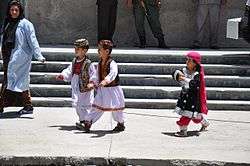 Boys wearing Khet partug
Boys wearing Khet partug Group of Afghans during the Second Anglo-Afghan War
Group of Afghans during the Second Anglo-Afghan War
Gallery Firaq partug
 Afghan girls in traditional clothes
Afghan girls in traditional clothes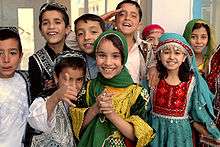 Afghan School children in Kabul
Afghan School children in Kabul 2010 Children's Day in Afghanistan
2010 Children's Day in Afghanistan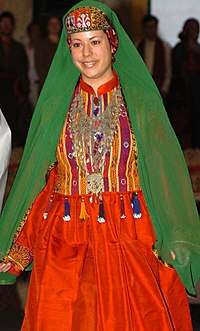 GI walks down the runway during a fashion show dressed in a colorful, traditional Afghan dress. The March 3, 2008
GI walks down the runway during a fashion show dressed in a colorful, traditional Afghan dress. The March 3, 2008 Afghan kids wearing traditional clothes in Kabul
Afghan kids wearing traditional clothes in Kabul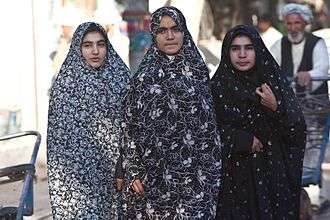 2009 Herat Afghanistan women wearing chador
2009 Herat Afghanistan women wearing chador Firaq partug of the Kuchi region
Firaq partug of the Kuchi region Women wearing firaq partug
Women wearing firaq partug An Afghan girl circa 1879
An Afghan girl circa 1879
Gallery perahan tunban
 Man in Afghan clothing: Perahan tunban
Man in Afghan clothing: Perahan tunban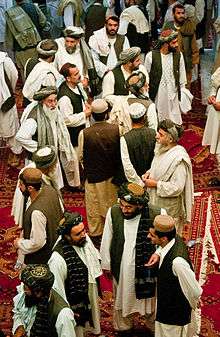 Men wearing perahan tunban in the southern city of Kandahar
Men wearing perahan tunban in the southern city of Kandahar Men wearing Perahan tunban, form of shalwar kameez at Kabul Airport in Afghanistan
Men wearing Perahan tunban, form of shalwar kameez at Kabul Airport in Afghanistan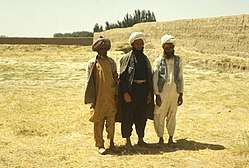
 Pasztun - Qajsār - 001621s
Pasztun - Qajsār - 001621s
See also
- Peshawari chappal, a type of Pashtun footwear mostly worn in the Peshawar region
- Pashtun culture
- Shalwar Kameez
- Khet partug
- Peshawari Pagri
- Perahan tunban
- Firaq partug
- 1970s in Afghan fashion
- 2000s in Afghan fashion
- 2010s in Afghan fashion
- www.AfghanFashion.Com
References
- ↑ "Pashtun - Introduction, Location, Language, Folklore, Religion, Major holidays, Rites of passage". Everyculture.com. Retrieved 16 September 2017.